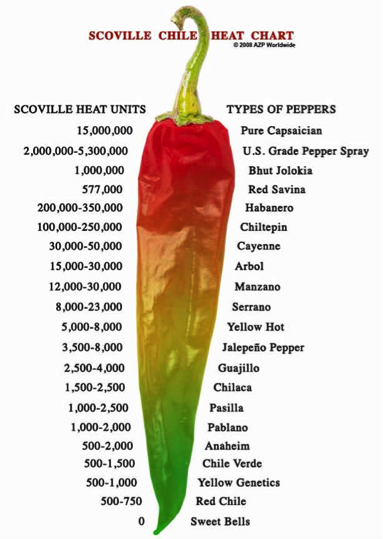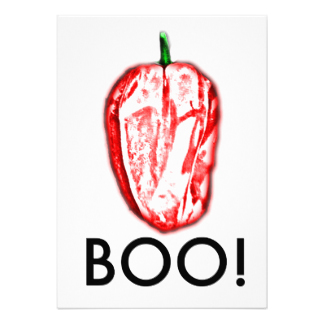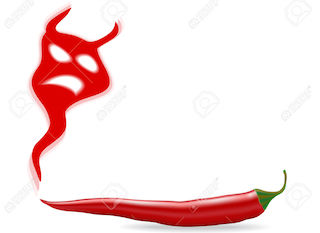As Halloween arrives, ‘trick or treat’ is a popular phrase used to get a handful of delicious, sweet morsels. But what if you did get tricked? What if instead of a chocolate malt ball, you were handed a chili pepper? Not just any chili pepper, but a ghost chili pepper. Now that is scary…

Source: http://www.ibtimes.co.uk/robber-wears-ghostface-scream-mask-terrorise-oklahoma-stores-during-halloween-month-1471282
With a nickname like ‘ghost,’ you might expect the pepper to be somewhat scary or unforgiving, and that is exactly the character this pepper assumes. In recent years, the ghost pepper lost its Guinness Book of World Records title as ‘world’s hottest pepper’ to the “Carolina Reaper”. [1] Despite the loss of its title, this pepper still packs a powerful punch and continues to make headlines for some good, bad, and intriguing reasons…
In September 2016, several children in middle school in Milton-Union, OH chose to eat ghost chili peppers and some had extreme reactions including blotchy skin, hives, tearing of the eyes, sweating and discomfort; some children even experienced vomiting. One child claimed to have broke out in a rash and temporarily lost the ability to see properly. About 40 children were involved in the incident and received medical treatment from paramedics. Five students were taken to the hospital, but luckily all of the children recovered. [2][3]

Source: http://giphy.com/gifs/melissa-mccarthy-bridesmaids-OJSXXAmxGxL5m
Again, consuming a ghost pepper was cited as the cause for an even more alarming repercussion. A 47-year-old man entered an eating contest consisting of a hamburger containing ghost pepper puree. Upon consuming the burger, he experienced extreme stomach and chest pain accompanied by forceful vomiting after drinking several glasses of water attempting to mitigate the pain. The pain did not subside, forcing him to seek medical attention, only to find out that he had burned a hole through his esophagus! [4]

Source: http://giphy.com/gifs/FVIflnMFdGoMw
The man received surgery but remained in the hospital for 23 days! No treat here.
With an experience like that, I firmly believe there is evidence that the ghost pepper is scary…
For many, the intense burning irritation one receives when consuming this perilous pepper is part of its allure. But what exactly is this perceived heat, and can it truly harm those bold souls daring enough to invoke its wrath?
The Scoville Method is a widely accepted means of discovering just how hot peppers can be. The units for Scoville ratings are “Scoville Heat Units” or SHU’s. This measure is the highest dilution of a chile or a chile pepper extract at which heat can be detected by a taste panel. Since the development of this rating, more accurate and efficient alternative methods (i.e. high performance liquid chromatography (HPLC) have been developed for measuring Scoville ratings [5]. The ghost pepper reigns in at 1 million SHU, which easily exceeds the 3,500-8,000 SHU of the jalapeño pepper so commonly included in our daily meals. These levels of heat are indicative of how our body’s trigeminal system might react to consuming a specific chili pepper. Trigeminal nerves are innervated among oral and nasal cavities, which provide information regarding thermal, tactile, and irritating or painful sensations. These nerves are chemically sensitive making them critical to flavor identity. [5] The active component in chili peppers responsible for the irritating sensations is known as capsaicin. The trigeminal system is therefore why we sense and perceive spiciness and also why more intense (irritant) physical reactions might occur after consumption, such as those experienced by the dare devil middle school children.

Source: http://www.eatmorechiles.com/Scoville_Heat.html
IF THEY ARE SO SCARY, THEN WHY DO WE EAT THEM?!
It is well known that these peppers were designed to give us pain, not pleasure. If they are so painful, why do we find them appealing? Paul Rozin theorizes the liking of peppers as ‘benign masochism’ and describes our liking by referencing human attraction to roller coasters, and jumping out of planes—concluding that we are in it for the thrill. He is quick to explain that he also believes there is more contributing psychologically to our persistent indulgence. Aspects such as consistent exposure mediate our attraction to painful pepper eating. Rozin states that the thrill might be associated with the fact that the heat sensation and reaction are harmless, allowing indulgence in ‘constrained risk’. [6]
Ironically there might be some good to consuming the ghost pepper in all its ghastly glory. It has been touted to harness some beneficial effects such as a mediator for stomach ailments, and its ability to lower blood pressure and have antimicrobial effects. [7] It can also be a cool-down mechanism since activation of TRPV1, the receptor capsaicin activates, causes a drop in body temperature. [8] It might also be appealing that spicy foods may help regulate your diet by promoting satiety, fat oxidation and thermogenesis, meaning your body may expend extra energy as heat, compensating for excess food intake and helping mitigate weight gain. [9]

Source: http://www.zazzle.com/scary+ghost+invitations
Just like anything scary that comes along, ghost chili peppers are (usually) not as bad as they seem. However, one must be cautious when consuming chili peppers with such irritating potential. Perhaps the scariest aspect of the ghost chili is that the same species of pepper can have different Scoville ratings depending on its growing conditions [10], and post harvest ripening conditions so be wary the next time you seek a chili pepper thrill of your own. [11]
References
[1] (http://blogs.kcrw.com/goodfood/2011/01/bhut-jolokia-the-hottest-pepp/)
[4] Arens A, Ben-Youssef L, Hayashi S, Smollin C (2016) Esophageal rupture after ghost pepper ingestion. J Emerg Med
[5] Wall M, Bosland P (1998) Analytical methods for color and pungency of chiles (capsicums). Developments in Food Science 39:347-373
[6] Rozin P, Schiller D (1980) The nature and acquisition of a preference for chili pepper by humans. Motiv Emotion 4:77-101
[7] http://www.nytimes.com/2010/09/21/science/21peppers.html?pagewanted=all
[8] Gavva NR (2008) Body-temperature maintenance as the predominant function of the vanilloid receptor TRPV1. Trends Pharmacol Sci 29:550-557
[9] Westerterp-Plantenga M, Diepvens K, Joosen AM, Bérubé-Parent S, Tremblay A (2006) Metabolic effects of spices, teas, and caffeine. Physiol Behav 89:85-91
[10] Thomas BV, Schreiber AA, Weisskopf CP (1998) Simple method for quantitation of capsaicinoids in peppers using capillary gas chromatography. J Agric Food Chem 46:2655-2663
[11] Iwai K, Lee K, Kobashi M, Suzuki T (1977) Formation of pungent principles in fruits of sweet pepper, Capsicum annuum L. var. grossum during post-harvest ripening under continuous light. Agric Biol Chem 41:1873-1876






Leave a Reply